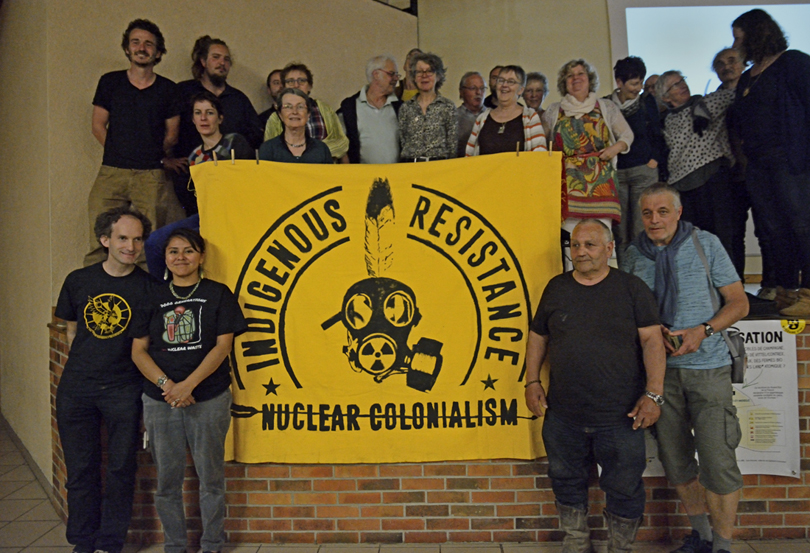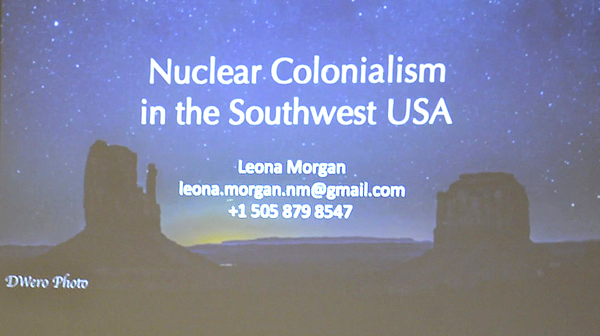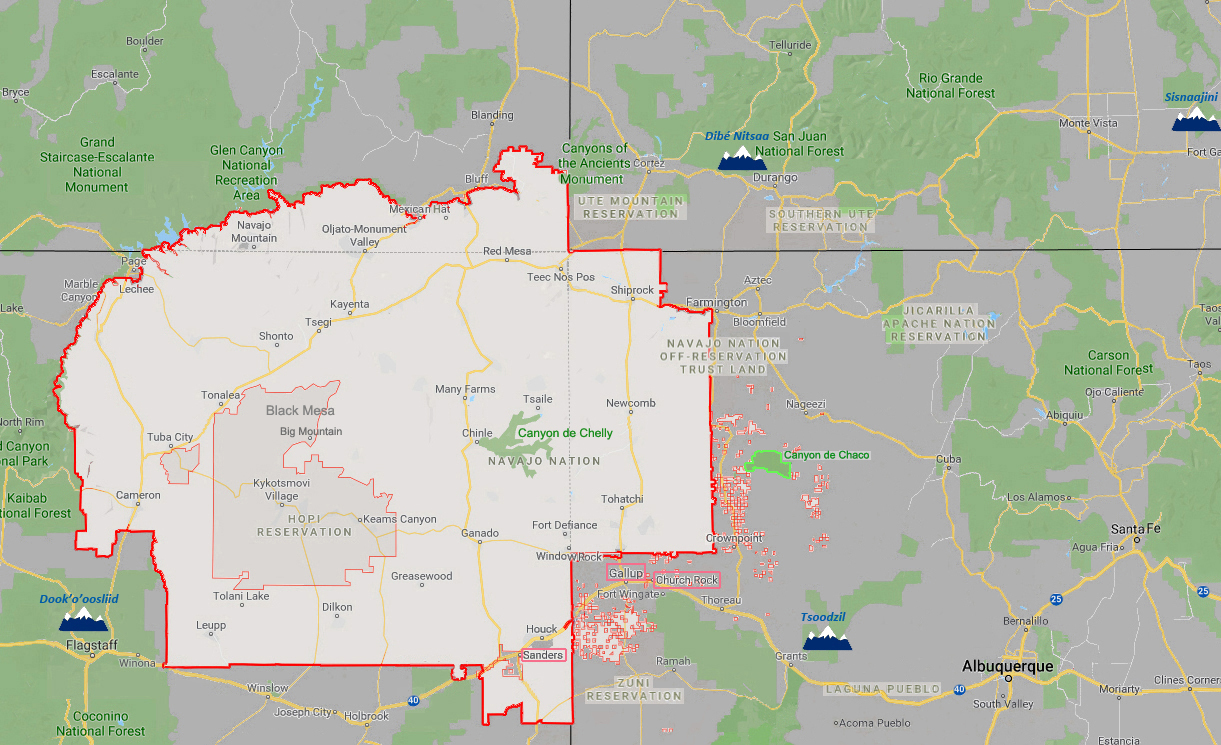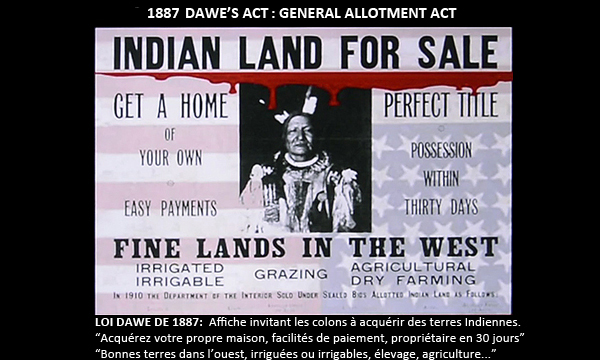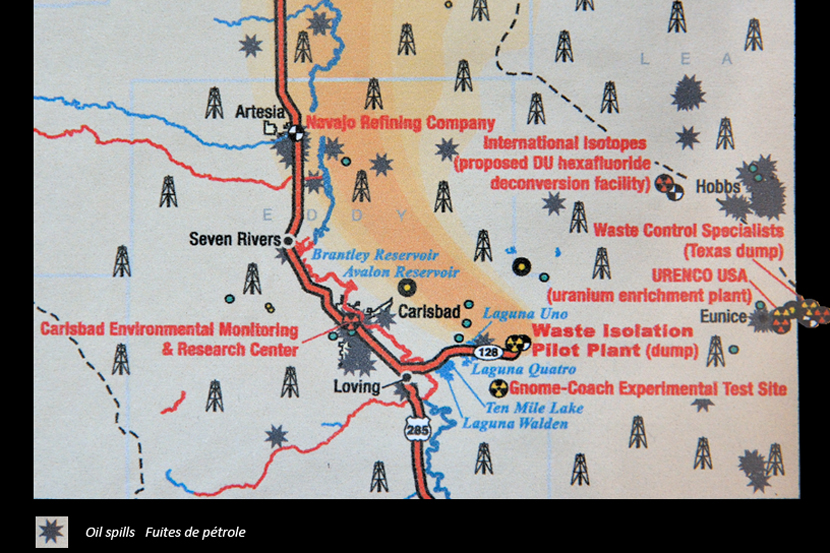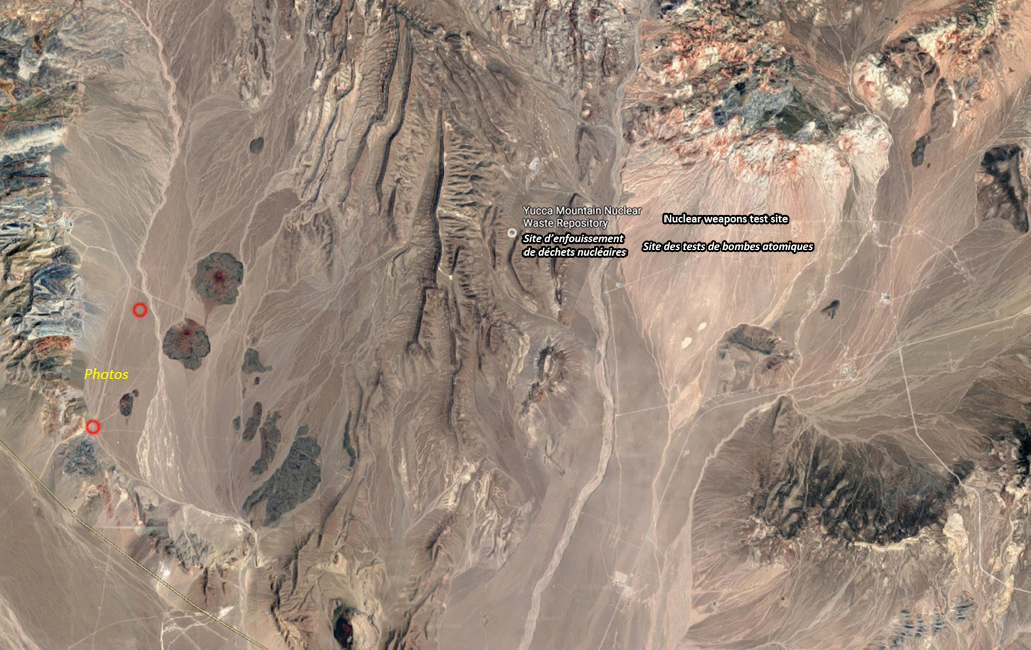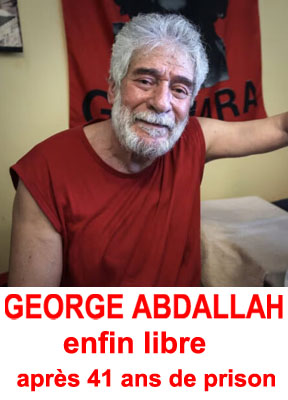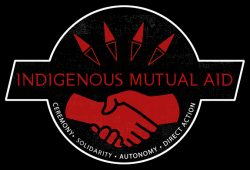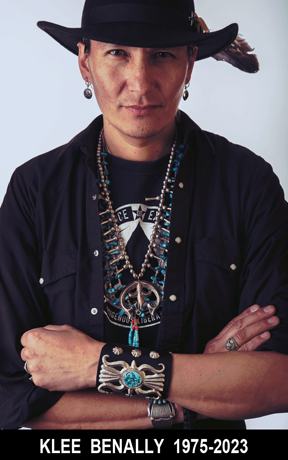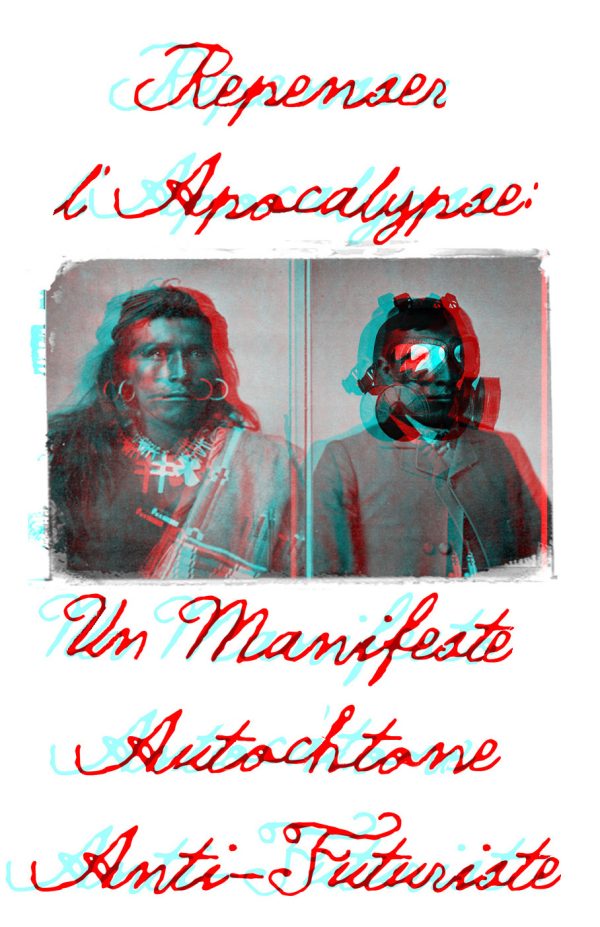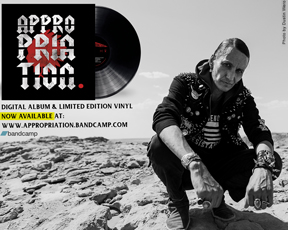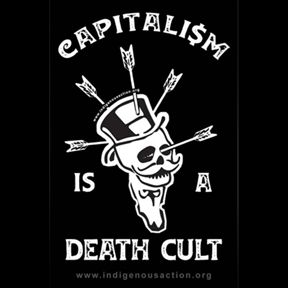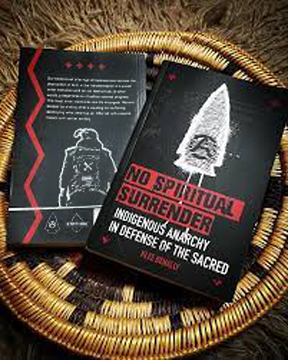In May-June 2019, Leona Morgan, Diné [Navajo] and anti-nuclear activist, came to Europe. On initiative of Pascal Grégis, member of the CSIA-nitassinan, she was invited by the CSIA, CEDRA, Meuse Nature Environnement and the Réseau Sortir Du Nucléaire, to visit the Bure area in eastern France, where people are fighting against a project of deep burial, highly radioactive nuclear waste site, and talk about the situation in New Mexico. She started her European trip there, on May 24. She first visited the area – as far as the military police let people go – and talked at a meeting in Bettancourt-la-Ferrée in the evening.
Lecture by Leona Morgan
Article Christine Prat Français
Photos Bure and New Mexico, Christine Prat
Slides Leona Morgan
Also published on Censored News
Bure is a small village (about 80 inhabitants) in eastern France. In 1994, the French government announced their intention to open a so-called “underground scientific research laboratory”, 1650 ft deep, on land near the village. As a matter of fact, the real purpose is to bury highly radioactive nuclear waste. The project, under the name CIGEO (Industrial Center for GEOlogical storage), is implemented by ANDRA (National Agency for RAdioactive Waste management) and started with the industrial conception phase in 2012. They plan to dig a waste disposal site, 1650 ft under the ground. The site would consist of tunnels covering 3700 acres. It would receive 350 000 cubic feet of ‘high activity, long life’ waste, and 2.6 million cubic feet of ‘medium activity, long life’ waste. The site would be dug in a wood which has already been fenced (the fence being a few feet inside the wood, hidden by trees). Cutting of trees has already started behind the fence. They would also build an interim storage area to store waste until it cools off. From there, they would dig a conveyor, several miles long, to carry the waste from the cooling area to the deep storage site. They also plan to dig vertical pits with lifts to bring workers and equipment down. According to the organization ‘Réseau Sortir du Nucléaire’, burying nuclear waste is not a solution, but the only way to conceal it. The region is thinly populated, that is why it has been chosen as ‘sacrifice zone’.
LEONA MORGAN’S LECTURE
Remark: All places named in the discussion can be found on the maps included in the article. When it is too small to read, click on the map to see it larger.
After having thanked the organizations that invited her and the audience, Leona introduced herself in Diné, according to the traditional way: after telling her name, she named her mother’s clan (that she is born from) and then her father’s clan (that she is born for).
She started her presentation showing a photo of Monument Valley, a world famous site, at a time very much used by Hollywood people for western movies, but also the place where the very first uranium mines in Diné (Navajo) territory were dug, in the 1940’s, and thus one of the first places plagued by uranium mining.
Her work started in 2007, first to fight a uranium mine, later the entire nuclear industry.
She explained how her people view the universe and how the United States used her people and stole their land. Leona said “In the United States, there are about 264 Tribes which are recognized by the Federal Government.” She said that before the conquest there were thousands of Indigenous Nations that were all impacted by colonialism, but that she would only talk about her own people, the Diné. “Our people live traditionally, my ancestors are from an area that we call Diné Bikeyah, ‘our land’. Our territory was between 4 sacred mountains. They identify, for my people, where we are to live forever. So later, after the process of colonization, all the imaginary borders were drawn that identify today, in the United States, the states of Arizona and New Mexico, as well as what we call the Navajo Nation.” She explained the difference between what they call ‘Diné Bikeyah’, their traditional territory, and the Navajo Nation, which means, according to context, the Navajo Reservation or the Tribal Council. Leona’s people come from a place north of Gallup, in New Mexico.
The nuclear fuel chain
“At the beginning, we have uranium mining which takes uranium out of the ground. The mining of uranium can be done through a process of taking it off the ground, or another process where you use liquid to take it out, a bit like fracking, we call it in-situ leaching.” In-situ leaching is a process used to extract uranium from layers of rock in aquifers. Naturally, uranium ore does not dissolve in the water, so they inject chemicals into the rocks and then filter the water to get the uranium ore. From mines, they extract rocks containing uranium ore and take them to a mill where they are processed to separate the uranium from the ore. Leona says “In our region, if you mine a ton of ore out of the ground, you have only about 5 pounds of actual uranium and 1995 pounds of waste.” She adds “When you take the ore from the mine to the mill and process it, the mill waste contains many chemicals and they create more radioactive waste. It’s not like a natural rock, it has been chemically changed and more radioactive.”
Then the uranium itself has to be enriched. There is only one enrichment facility in the United States, and it happens to be in New Mexico. After enrichment, fuel is made for nuclear power plants. “And the waste of a nuclear power plant is high level radioactive waste. After enrichment, if it is for weapons, it goes to labs to make nuclear weapons. Contaminated tools and other waste from weapons constitute “transuranic” waste, ending with plutonium. And of course, we end up with nuclear weapons. The waste from that is depleted uranium.”
Indigenous people consider the presence of nuclear facilities and their impacts on their territories as nuclear colonialism. Leona says “As Indigenous persons, we are not just fighting the nuclear industry, but we are also fighting the racism, the capitalism and imperialism of the United States, that continue today to take our land, to hurt our culture, and use our people and our Mother Earth for the industry of war and greed.”
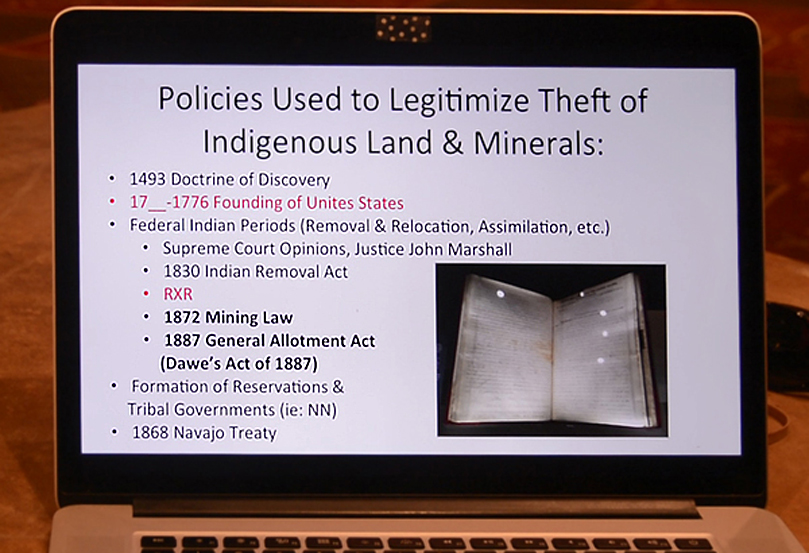 The process of conquest of the land and elimination of the Indigenous Peoples started in 1493, with what is called the Doctrine of Discovery, which Indigenous Peoples are still fighting today. It is a Papal Bull – thus an undisputable decision by the Pope. The document says that “the Church has commission from God to kill other people and take their lands, because they are less than human.” It is still used today by colonizing countries in Africa and by the United States and Canada. Leona says that “the United States based some of their early laws on this document.” In the 18th century, when the United States were forming, they had a policy of genocide, trying to kill all Indigenous Peoples. At the time, it did not really work, so they adopted a policy of relocation, pushing Indigenous Peoples westward. In the late 19th century – while they tried again to exterminate Natives – they started the so-called ‘assimilation’ policy: it meant destroying Indigenous culture and turn the Native into a western person. The phrase used was ‘Kill the Indian, Save the man’.
The process of conquest of the land and elimination of the Indigenous Peoples started in 1493, with what is called the Doctrine of Discovery, which Indigenous Peoples are still fighting today. It is a Papal Bull – thus an undisputable decision by the Pope. The document says that “the Church has commission from God to kill other people and take their lands, because they are less than human.” It is still used today by colonizing countries in Africa and by the United States and Canada. Leona says that “the United States based some of their early laws on this document.” In the 18th century, when the United States were forming, they had a policy of genocide, trying to kill all Indigenous Peoples. At the time, it did not really work, so they adopted a policy of relocation, pushing Indigenous Peoples westward. In the late 19th century – while they tried again to exterminate Natives – they started the so-called ‘assimilation’ policy: it meant destroying Indigenous culture and turn the Native into a western person. The phrase used was ‘Kill the Indian, Save the man’.
“Other tools were also used to steal our lands, like the railroads, mining, and now what we call tribal governance. I want people to understand that mining and nuclear testing today are based on these old laws which people think are history. But they are very relevant and they are used today to continue this process of genocide through what we call nuclear colonialism” Leona said. 85% of uranium mining in the world happens on Indigenous land. Today, people affected are still fighting to get their land cleaned up and get help with their health problems. Diné people who developed cancers and family members of those who died, had to fight for decades in court before their diseases were recognized as being caused by uranium and they could get some compensation.
“We call it environmental racism” Leona said. “They did the same thing with nuclear weapons, because the testing of nuclear weapons was done on land of Indigenous Peoples and Peoples of color”. In the United States, about 1000 atomic bombs exploded on Western Shoshone land, in so-called Nevada [see below]. They also had tests on Bikini, Marshall Islands, which is still unhabitable today. The French made their atomic tests in Reggane, Algeria, in Tuareg territory, until 1967. In 1966, they started “testing” in Mururoa, in “French” Polynesia.
Mining was also a colonization tool, encouraging white settlers to move west. Leona says “Through mining, people were able to take away land from our people by that law called Mining Law 1872. This law allows people to mine on U.S. public lands, they are not to pay any royalties, but a fee of only $10 a year on U.S. public lands.” Some white environmental organizations in the United States want to change the law, but they are only concerned about the environment and don’t include Native People or People of color. They mainly want companies to pay more for mining, but it does not include protection of Indigenous Peoples sacred places or reparations for the land that was stolen.
General Allotment Act
The law called General Allotment Act was used to try to remove Native Peoples from their land. It was also meant to destroy native culture, as Native peoples never knew private property, and never believed that they could own any part of Mother Earth. This law created individual portions of land called ‘allotment’ to be owned by individual Indian owners.  East of the Navajo Reservation, it created the so-called ‘checkerboard area’. This is the area where Leona’s family is from. In this area, are many types of land jurisdiction. Today, allotments are owned by government, corporations, private persons or Indigenous people, who can be the Navajo Nation or individuals called ‘allotees’. At that point, Leona explains that “there is a big difference when I say ‘Navajo Nation’, which means government, and when I talk about the people.”
East of the Navajo Reservation, it created the so-called ‘checkerboard area’. This is the area where Leona’s family is from. In this area, are many types of land jurisdiction. Today, allotments are owned by government, corporations, private persons or Indigenous people, who can be the Navajo Nation or individuals called ‘allotees’. At that point, Leona explains that “there is a big difference when I say ‘Navajo Nation’, which means government, and when I talk about the people.”
United States created ‘Navajo Government’
The Navajo Tribal Council was created in 1923 by the United States government. Leona says “Part of the process of colonization was the creation of government, which was a different system than what Indigenous People ever had. For our people, the Navajo Nation is the name of our government, also of the land that we sometimes call the Reservation. We have our plots, we have our system, but it’s all a copy of the United States.” Still, in 2005, the Navajo Nation passed a law that banned uranium mining, the Diné Natural Resources Protection Act. In 2012, a law prohibiting transport of radioactive materials was passed. However, those laws are not respected by the states (Arizona or New Mexico) or by the federal government. The sacred sites between the four sacred mountains are not protected either, because they are outside the Navajo Nation. Even places inside the Navajo Nation cannot be protected because they are controlled by the states or the federal government, like roads and railroads crossing the reservation. The Navajo Nation does not have control on the airspace either.
THE SITUATION IN NEW MEXICO
New Mexico has almost every step of the nuclear chain, except for nuclear power plants. In the United States are over 15 000 abandoned uranium mines, a few in the east of the country, but most in the west. These mines were mostly supplying uranium for nuclear weapons. Most mining happened from the 1940’s into the 1980’s. The United States Environmental Protection Agency (EPA) was not created before December 1970. Until then, there were no laws to protect the environment, workers or the public. Few of these mines have been cleaned up. The Navajo Nation is one of the few places where something is done, the Tribal government working with the federal government to cleanup about 500 mines.
Churchrock disaster, 1979
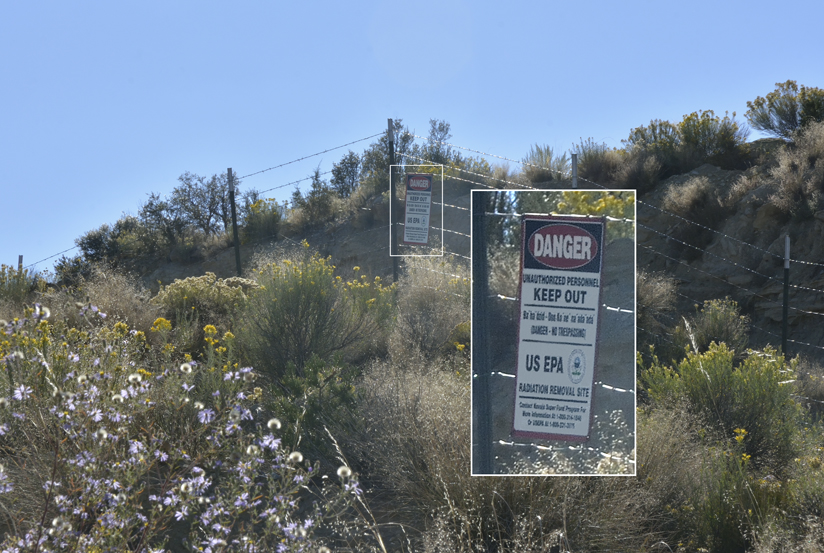 On July 16th, 1979, the worst nuclear disaster in the history of the United States, took place in Churchrock, New Mexico. In Churchrock were two uranium mines and a processing mill. The mill had a tailings pond to hold the waste from the mill. Waste from a processing mill is much more radioactive than mine waste. That pond was closed by a dam made of clay. There was a crack in it, the company and the government knew it, but the company kept putting waste in the pond. In the morning of July 16th, 1979, the dam broke. 90 million gallons of radioactive waste spilled into a dry ravine, and further in a mostly dry river, the Puerco River.
On July 16th, 1979, the worst nuclear disaster in the history of the United States, took place in Churchrock, New Mexico. In Churchrock were two uranium mines and a processing mill. The mill had a tailings pond to hold the waste from the mill. Waste from a processing mill is much more radioactive than mine waste. That pond was closed by a dam made of clay. There was a crack in it, the company and the government knew it, but the company kept putting waste in the pond. In the morning of July 16th, 1979, the dam broke. 90 million gallons of radioactive waste spilled into a dry ravine, and further in a mostly dry river, the Puerco River.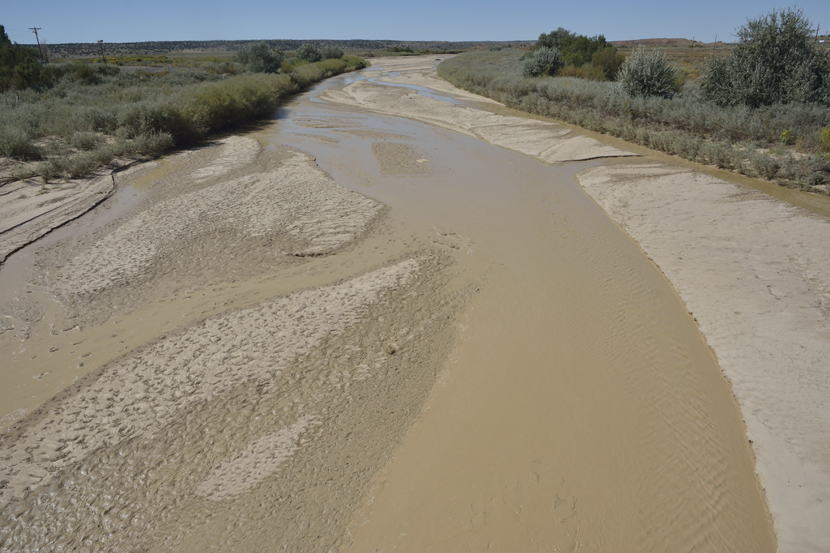 It usually has no water, but after the spill occurred, it rained, so the river was full of water and flowed 100 miles away into Arizona. It happened only a few months after the Three-Miles-Island accident, in Harrisburg. Although the spill in Churchrock was the worst nuclear accident ever, it got almost no media coverage and no public attention. Harrisburg is in the east, in a densely populated area, mostly white people (there has been a movie about the accident, starring Meryl Streep). In Churchrock, there are not so many people, mostly Indigenous.
It usually has no water, but after the spill occurred, it rained, so the river was full of water and flowed 100 miles away into Arizona. It happened only a few months after the Three-Miles-Island accident, in Harrisburg. Although the spill in Churchrock was the worst nuclear accident ever, it got almost no media coverage and no public attention. Harrisburg is in the east, in a densely populated area, mostly white people (there has been a movie about the accident, starring Meryl Streep). In Churchrock, there are not so many people, mostly Indigenous.
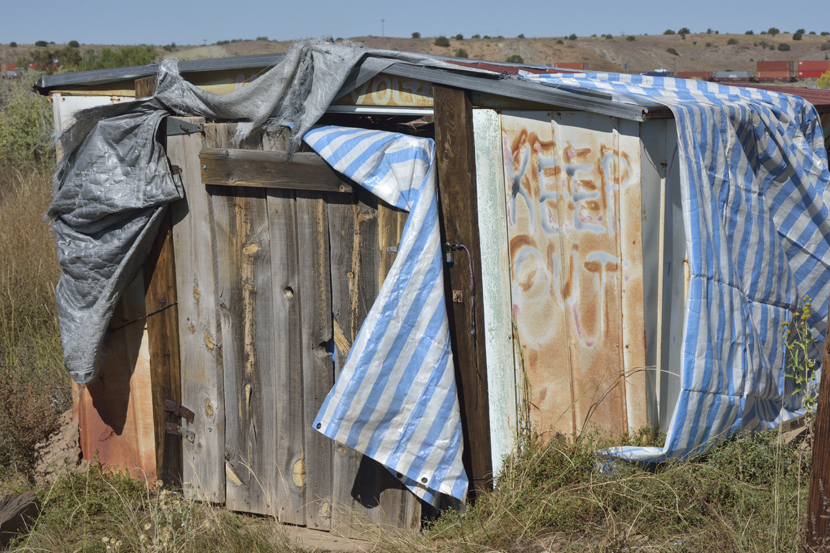 Today, it still has not been cleaned up. In July 2015, Tommy Rock, a Diné scholar from the Northern Arizona University, found that the drink water, in a Diné community in Sanders, Arizona, 40 miles downstream on the Puerco River, had two times the legal level of uranium. The children at the local school were given bottled water to drink. The community is still fighting for cleanup. They want the waste to go off the Navajo Nation, away from their homes. “But,” says Leona, “because of the checkerboard area, which is out of the Reservation, the government piled up waste quite close to their homes, and the wind brings it back.” She adds “Uranium mining was banned in 2005, but it is uranium mines from the 1980’s which are still affecting the animals and the community.” People want the mines to be cleaned up. The company is proposing to scrape the radioactive dirt, put it above the mill’s waste and cover it with clay, saying it would be safe for a thousand years. But their plan applies only inside the private land of the company and will not include the whole area of the spill, 100 miles west. People fear another spill. The Puerco is a dry river, but heavy rains can always occur.
Today, it still has not been cleaned up. In July 2015, Tommy Rock, a Diné scholar from the Northern Arizona University, found that the drink water, in a Diné community in Sanders, Arizona, 40 miles downstream on the Puerco River, had two times the legal level of uranium. The children at the local school were given bottled water to drink. The community is still fighting for cleanup. They want the waste to go off the Navajo Nation, away from their homes. “But,” says Leona, “because of the checkerboard area, which is out of the Reservation, the government piled up waste quite close to their homes, and the wind brings it back.” She adds “Uranium mining was banned in 2005, but it is uranium mines from the 1980’s which are still affecting the animals and the community.” People want the mines to be cleaned up. The company is proposing to scrape the radioactive dirt, put it above the mill’s waste and cover it with clay, saying it would be safe for a thousand years. But their plan applies only inside the private land of the company and will not include the whole area of the spill, 100 miles west. People fear another spill. The Puerco is a dry river, but heavy rains can always occur.
Out of the 15 000 abandoned mines, this is the most affected place in the United States.
Nuclear facilities in New Mexico
Right now, New Mexico is filled with nuclear facilities.
The ‘Trinity’ site is where the first atomic bomb was exploded. It was the first test ever, shortly before dropping the bombs on Hiroshima and Nagasaki.
There are also two national labs making nuclear weapons. Leona says “Our state of New Mexico we call nuclear Mexico”.
There are uranium mines and mills. There is an enrichment facility, the only one in the United States, run by URENCO USA. There is a storage facility for highly radioactive waste used for making weapons. There are nuclear weapons stored in several places (one being practically in Albuquerque, under the mountain). There is also the largest open pit uranium mine in the world (in Laguna territory). It is closed and they are trying to clean it up. There are new proposals for uranium mining and they want strip mining.
Southeast New Mexico
Leona explained “In the Southeast, there is the WIPP, Waste Isolation Pilot Plant, licensed to store transuranic radioactive waste for 10,000 years. 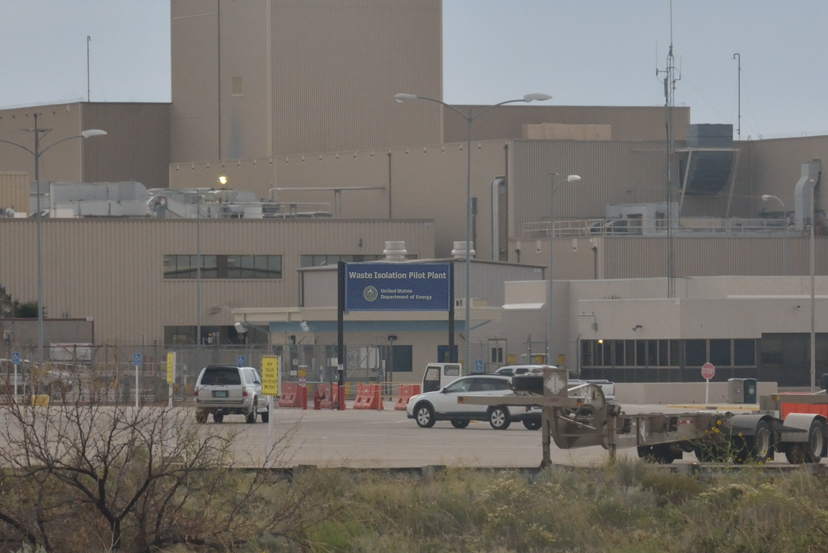 The waste is from the research and production of United States nuclear weapons. It is located in an area known as the southeastern New Mexico nuclear corridor which also includes the National Enrichment Facility near Eunice, New Mexico,” (the mill named above, run by URENCO), “the Waste Control Specialists low-level waste disposal facility just over the border near Andrews, Texas, and the International Isotopes, Inc. facility to be built near Eunice, New Mexico. There are uranium waste sites, and ELEA processing mill, very close to the WIPP. In Texas, just over the border with New Mexico, there is another waste site for low level radioactive waste.”
The waste is from the research and production of United States nuclear weapons. It is located in an area known as the southeastern New Mexico nuclear corridor which also includes the National Enrichment Facility near Eunice, New Mexico,” (the mill named above, run by URENCO), “the Waste Control Specialists low-level waste disposal facility just over the border near Andrews, Texas, and the International Isotopes, Inc. facility to be built near Eunice, New Mexico. There are uranium waste sites, and ELEA processing mill, very close to the WIPP. In Texas, just over the border with New Mexico, there is another waste site for low level radioactive waste.”
“Now, we are fighting two proposals for two high level nuclear waste site. In the United States, there is no site for high level radioactive waste. The two proposals for high level waste storage in New Mexico are called interim or temporary sites. The idea is to bring waste to New Mexico only temporarily. New Mexico people don’t believe this, they think that if it starts temporarily, it will become permanent” (What they call ‘temporary’ can be up to 30 years).
“Currently, temporary storage sites are not legal. So, they are trying to change the law to make it legal, and although it is not legal, the House approved in Congress funding for the company Holtec. Holtec builds containers for nuclear waste, and there are many problems with these containers. We are fighting the company at every level. There were 7 cases filed against Holtec, but none of them was accepted by the federal government. All our arguments have been rejected. Holtec also builds small reactors and recycles nuclear waste. We also heard a rumor that Holtec wants to bring all nuclear waste of the country to New Mexico and we suspect that they also do reprocessing in the area. Currently, there is no reprocessing in the United States. 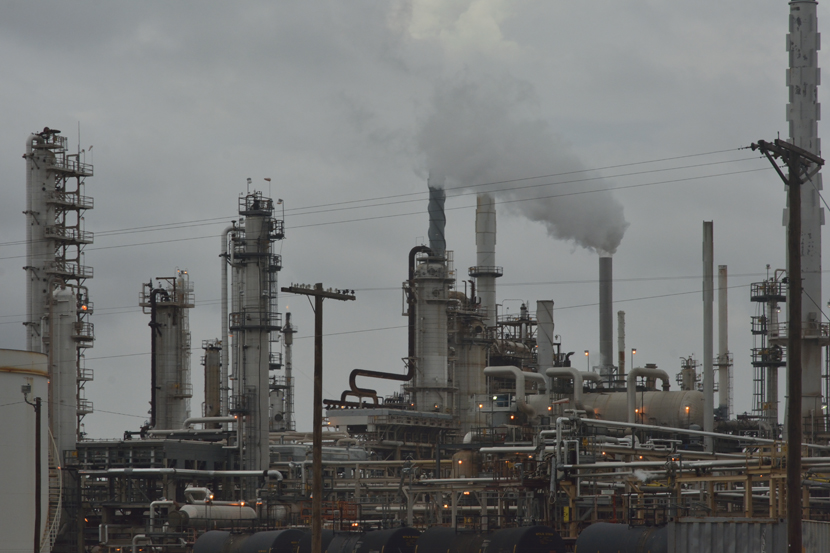 Our fight focusses now on the south east corner, where there is also one of the largest oil deposits in the world. Thus, there is fracking and it is not really safe to put nuclear waste there.”
Our fight focusses now on the south east corner, where there is also one of the largest oil deposits in the world. Thus, there is fracking and it is not really safe to put nuclear waste there.”
Two accidents happened in salt mines used to store nuclear waste. One mine took fire, in 2014, then a container exploded.
Other struggles in the Southeast of the U.S.A.: Yucca Mountain and Canyon Mine
Leona explained “In the United States are Indigenous People who call themselves the most bombed Nation in the world. The United States have exploded about 1000 atomic bombs on Western Shoshone land. It is related to the nuclear waste issue, because it is an area where they also want to place nuclear waste from the power plants, at a site called Yucca Mountain. 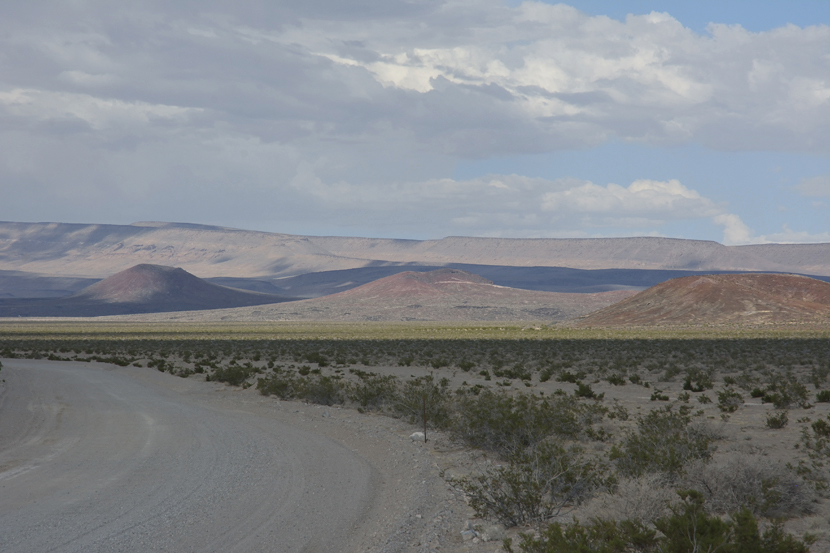 “The Shoshone are still fighting against that project of deep burial waste site. Yucca Mountain is quite close to the site where the atomic bombs tests took place until 1992. It is also a volcanic region, there are 7 volcanos at the foot of Yucca Mountain. Currently, the legal base to fight against the waste project is the fact that it is on non-ceded Shoshone Territory according to the treaties signed with the U.S. government. (However, the United States never respected a single treaty signed with Indigenous Nations).
“The Shoshone are still fighting against that project of deep burial waste site. Yucca Mountain is quite close to the site where the atomic bombs tests took place until 1992. It is also a volcanic region, there are 7 volcanos at the foot of Yucca Mountain. Currently, the legal base to fight against the waste project is the fact that it is on non-ceded Shoshone Territory according to the treaties signed with the U.S. government. (However, the United States never respected a single treaty signed with Indigenous Nations).
Another major struggle which has been going on for years is that against the so-called ‘Canyon Mine’, near the Grand Canyon, in Arizona, where a company wants to extract uranium. Several communities are united against the mine. It includes the Havasupai people, who live at the bottom of the Grand Canyon. 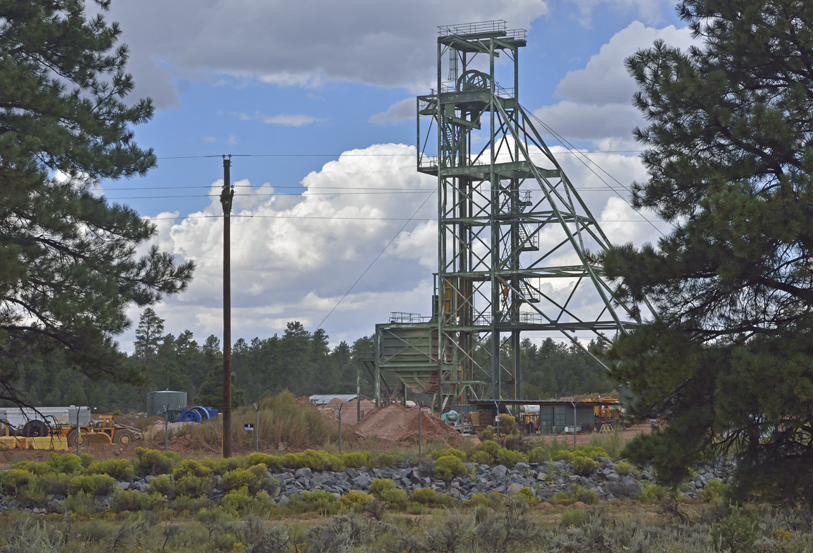 The mine is close to Red Butte, a sacred site for them. Moreover, they fear that water sources flowing toward the Grand Canyon, which provide water to the community, might be contaminated. “People are also fighting against the White Mesa processing mill, that impacts the Ute Mountain Ute Reservation. The company operating the Canyon Mine wants to transport the ore to White Mesa Mill, across the Navajo Nation. “This fight – led by ‘Haul No!’ – unites several communities from the Grand Canyon, from near the mill and those crossed by transport” says Leona, who is a member and co-founder of ‘Haul No!‘
The mine is close to Red Butte, a sacred site for them. Moreover, they fear that water sources flowing toward the Grand Canyon, which provide water to the community, might be contaminated. “People are also fighting against the White Mesa processing mill, that impacts the Ute Mountain Ute Reservation. The company operating the Canyon Mine wants to transport the ore to White Mesa Mill, across the Navajo Nation. “This fight – led by ‘Haul No!’ – unites several communities from the Grand Canyon, from near the mill and those crossed by transport” says Leona, who is a member and co-founder of ‘Haul No!‘
Nuclear Issues Study Group
Leona talked about a group she founded and in which she is working, the Nuclear Issues Study Group. “We are a new group fighting because of the racism that exists in environmental groups. Most groups are led by elderly white men. Our group is trying to bring in young people, we are women-led, indigenous-led and queer-led. This is meant to create a new resistance to nuclear weapons and the nuclear monster. The work I do is with Indigenous people.”
Nuclear Power is NOT clean!
“Some people say nuclear power is clean. We are focused in educating people that nuclear power is not clean. In the United States and other countries, there is a push to build new nuclear power plants. But when they measure the carbon print of nuclear energy, they only measure it at nuclear power plants. They don’t measure the carbon print from mining, processing, transport and storage.” She said as a conclusion.

